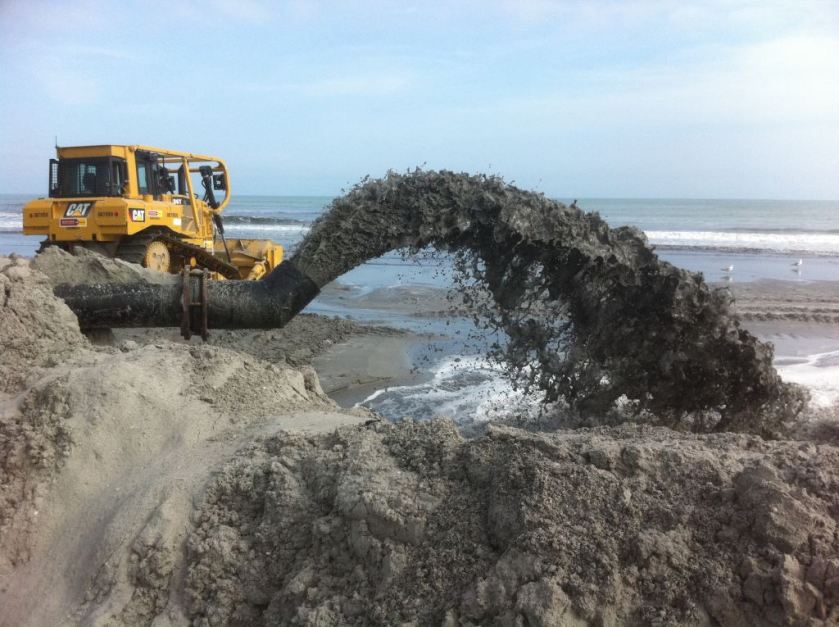Beaches are an important form of recreation, especially in the summer, but, because of climate change, they are in danger. Rising sea levels as well as the increased potential of dangerous storms exacerbate beachfront erosion. More than 70% of the world’s beaches are experiencing losses due to erosion (Bird 1985). One method of fixing this problem is beach nourishment. Though there are benefits to this solution, there are also large costs, both environmentally and financially.
Beach nourishment, or replenishment, is the act of removing sand from offshore sand bars located close to the beach and replenishing the beach with this sand. This is ideal because the sand is usually a close match to the grain size of the original sand. (Gornitz et. al 2002) If it is not a perfect match it will alter the sand composition of the beach, which can upset some beach goers. Beach nourishment is considered to be a soft approach because it is only a temporary fix to the large problem of erosion. It needs to be repeated often so as to continue the effect. This soft approach is preferred over hard approaches, such as the building of groins or sea walls, because those structures often cause increases in erosion down drift. Replenishment benefits communities because beaches increase tourism and, if located in residential areas, usually increase property values. In some cases, individuals are willing to pay for beach replenishment. Beaches also help to protect coastal areas from storms – they prevent sediment overwash and stop salt water from inundating coastal wetlands (ASBPA 2007).

Many New York City beaches have undergone beach nourishment. After the damaging effect of Hurricane Sandy, Rockaway Beach has had 3.7 million cubic yards of sand moved to restore its beach. In addition, Coney Island, the East and South Shore of Staten Island, and Orchard Beach in the Bronx were locations of beach nourishment. Hurricane Sandy also greatly damaged other beaches. In three waterfronts of NYC (New York Harbor, Raritan Bay, and Jamaica Bay) 25% of beaches and 28% of beaches along the Long Island Sound lost between 50 and 100 feet of sand due to the effects of erosion (Anderson 2013). With chances of severe storms increasing because of climate change, according to the IPCC Summary for Policy Makers (2013), one must expect that beach nourishment will be increasingly necessary if New York wants to retain current beach levels.
Moving that much sand has a cost. Gornitz, et. al (2002) states that over half a million dollars has been spent in New York state alone on beach replenishment. Rockaway Beach’s restoration project, which included reconstruction of the boardwalk, construction of baffle walls, and sand retaining walls, as well as beach nourishment, cost more than $140 million dollars. Before that $216 million had been spent to replenish Rockaway’s beaches (Nessen 2013). From 1923-1995, $25 million dollars was spent on beach nourishment for Coney Island. These costs will only increase in the future as more sand will be needed for replenishment and the sand closest to the beach will be depleted. In addition, sand added through beach nourishment erodes two to three times faster than natural beaches (Barber n.d.). This will add to the amount of nourishment needed.
As well as these financial effects, beach nourishment negatively affects the environment. The moving of sand can make the water too muddy, bulldozers can squish species that reside on the beach, or change the shape of the beach to such a level that it makes it impossible for certain species to reside there. After Hurricane Sandy, even though beaches were heavily eroded, there are possible positive effects for animals. The flattening of beaches in Breezy Point, the Rockaways, and Fire Island could enable the piping plover, which is endangered, to nest in new places (Anderson 2013). The changes on the beach caused by erosion or storms are natural and beneficial to animals that make their habitat on the shore, while human caused beach nourishment can make life difficult of species like sea turtles who lay eggs on beaches.
Beach nourishment is a complicated matter. While it helps protect coastal areas and allows for recreational use of beaches, it can also destroy ecosystems and be financially costly. In the fight to conserve recreational spaces in the face of climate change, we much decide whether protecting our beaches is worth the cost it carries.
Bibliography:
Anderson, J. 2013. Rebuilding the Coastline, but at What Cost?. New York Times. http://www.nytimes.com/2013/05/19/nyregion/rebuilding-the-coastline-but-at-what-cost.html?pagewanted=all&_r=1
ASPBA. 2007. Beach Nourishment: How Beach Nourishment Projects Work. ASPBA. http://www.asbpa.org/publications/fact_sheets/HowBeachNourishmentWorksPrimerASBPA.pdf
Barber, D. n.d. Beach Nourishment Basics. Bryn Mawr College. http://www.brynmawr.edu/geology/geomorph/beachnourishmentinfo.html
Bird, E.C.F., C. Wiley. 1985. Coastline Changes: A Global Review. 219 pp. New York, New York, USA.
Gornitz, V., S. Couch, and E. K. Hartig. 2002. Impact of sea level rise in the New York City metropolitan area. Global and Planetary Changes 32: 61-88.
IPCC, 2013: Summary for Policymakers. In: Climate Change 2013: The Physical Science Basis. Contribution of Working Group I to the Fifth Assessment Report of the Intergovernmental Panel on Climate Change [Stocker, T.F., D. Qin, G.-K. Plattner, M. Tignor, S. K. Allen, J. Boschung, A. Nauels, Y. Xia, V. Bex and P.M. Midgley (eds.)]. Cambridge University Press, Cambridge, United Kingdom and New York, NY, USA.
Nessen, S. 2013. The ‘Most Expensive Beach in America’ Gets More So. WNYC. http://www.wnyc.org/story/299390-dumping-more-sand-most-expensive-beach-america/
NYC Parks Department. n.d. Rockaway Beach Restoration. NYC Parks Department. https://www.nycgovparks.org/facility/beaches/beach-recovery
Image: https://www.seaturtlecamp.com/coastal-development/
